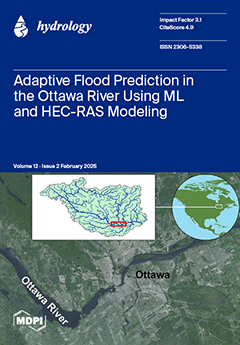The standardized hydrological index (
SHI) is the standardized but not normalized (normal probability variate) value of the streamflow used to characterize a hydrological drought, akin to the standardized precipitation index (
SPI, which is both standardized and normalized) in the realm of the meteorological drought. The time series of the
SHI can be used as a platform for deriving the longest duration,
LT, and the largest magnitude,
MT (in standardized form), of a hydrological drought over a desired return period of
T time units (year, month, or week). These parameters are predicted based on the
SHI series derived from the annual, monthly, and weekly flow sequences of Canadian rivers. An important point to be reckoned with is that the monthly and weekly sequences are non-stationary compared to the annual sequences, which fulfil the conditions of stochastic stationarity. The parameters, such as the mean, standard deviation (or coefficient of variation), lag 1 autocorrelation, and conditional probabilities from
SHI sequences, when used in Markov chain-based relationships, are able to predict the longest duration,
LT, and the largest magnitude,
MT. The product moment and
L-moment ratio analyses indicate that the monthly and weekly flows in the Canadian rivers fit the gamma probability distribution function (
pdf) reasonably well, whereas annual flows can be regarded to follow the normal
pdf. The threshold level chosen in the analysis is the long-term median of
SHI sequences for the annual flows. For the monthly and weekly flows, the threshold level represents the median of the respective month or week and hence is time varying. The runs of deficit in the
SHI sequences are treated as drought episodes and thus the theory of runs formed an essential tool for analysis. This paper indicates that the Markov chain-based methodology works well for predicting
LT on annual, monthly, and weekly
SHI sequences. Markov chains of zero order (
MC0), first order (
MC1), and second order (
MC2) turned out to be satisfactory on annual, monthly, and weekly scales, respectively. The drought magnitude,
MT, was predicted satisfactorily via the model
MT =
Id ×
Lc, where
Id stands for drought intensity and
Lc is a characteristic drought length related to
LT through a scaling parameter,
ɸ (= 0.5). The
Id can be deemed to follow a truncated normal
pdf, whose mean and variance when combined implicitly with
Lc proved prudent for predicting
MT at all time scales in the aforesaid relationship.
Full article





